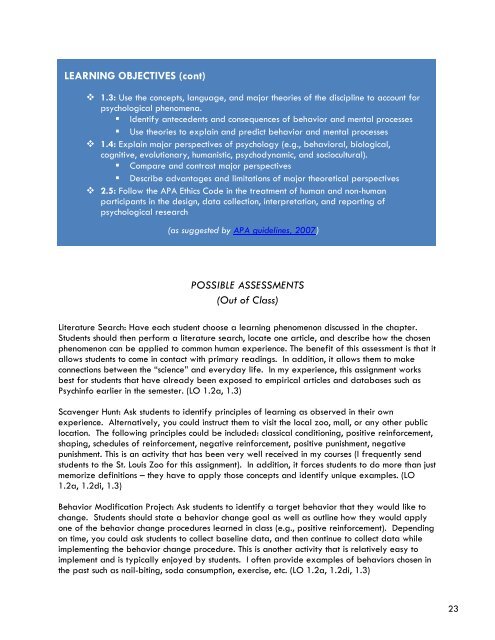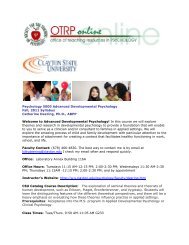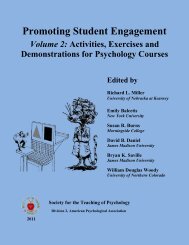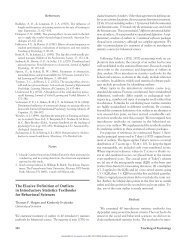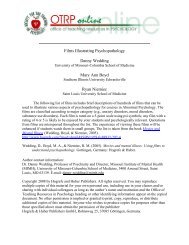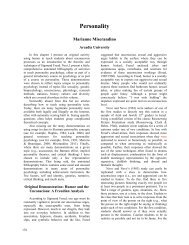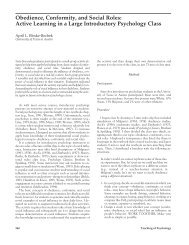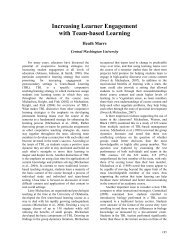INTRODUCTORY PSYCHOLOGY TEACHING PRIMER Early Career ...
INTRODUCTORY PSYCHOLOGY TEACHING PRIMER Early Career ...
INTRODUCTORY PSYCHOLOGY TEACHING PRIMER Early Career ...
Create successful ePaper yourself
Turn your PDF publications into a flip-book with our unique Google optimized e-Paper software.
LEARNING OBJECTIVES (cont)<br />
1.3: Use the concepts, language, and major theories of the discipline to account for<br />
psychological phenomena.<br />
Identify antecedents and consequences of behavior and mental processes<br />
Use theories to explain and predict behavior and mental processes<br />
1.4: Explain major perspectives of psychology (e.g., behavioral, biological,<br />
cognitive, evolutionary, humanistic, psychodynamic, and sociocultural).<br />
Compare and contrast major perspectives<br />
Describe advantages and limitations of major theoretical perspectives<br />
2.5: Follow the APA Ethics Code in the treatment of human and non-human<br />
participants in the design, data collection, interpretation, and reporting of<br />
psychological research<br />
(as suggested by APA guidelines, 2007)<br />
POSSIBLE ASSESSMENTS<br />
(Out of Class)<br />
Literature Search: Have each student choose a learning phenomenon discussed in the chapter.<br />
Students should then perform a literature search, locate one article, and describe how the chosen<br />
phenomenon can be applied to common human experience. The benefit of this assessment is that it<br />
allows students to come in contact with primary readings. In addition, it allows them to make<br />
connections between the “science” and everyday life. In my experience, this assignment works<br />
best for students that have already been exposed to empirical articles and databases such as<br />
Psychinfo earlier in the semester. (LO 1.2a, 1.3)<br />
Scavenger Hunt: Ask students to identify principles of learning as observed in their own<br />
experience. Alternatively, you could instruct them to visit the local zoo, mall, or any other public<br />
location. The following principles could be included: classical conditioning, positive reinforcement,<br />
shaping, schedules of reinforcement, negative reinforcement, positive punishment, negative<br />
punishment. This is an activity that has been very well received in my courses (I frequently send<br />
students to the St. Louis Zoo for this assignment). In addition, it forces students to do more than just<br />
memorize definitions – they have to apply those concepts and identify unique examples. (LO<br />
1.2a, 1.2di, 1.3)<br />
Behavior Modification Project: Ask students to identify a target behavior that they would like to<br />
change. Students should state a behavior change goal as well as outline how they would apply<br />
one of the behavior change procedures learned in class (e.g., positive reinforcement). Depending<br />
on time, you could ask students to collect baseline data, and then continue to collect data while<br />
implementing the behavior change procedure. This is another activity that is relatively easy to<br />
implement and is typically enjoyed by students. I often provide examples of behaviors chosen in<br />
the past such as nail-biting, soda consumption, exercise, etc. (LO 1.2a, 1.2di, 1.3)<br />
23


